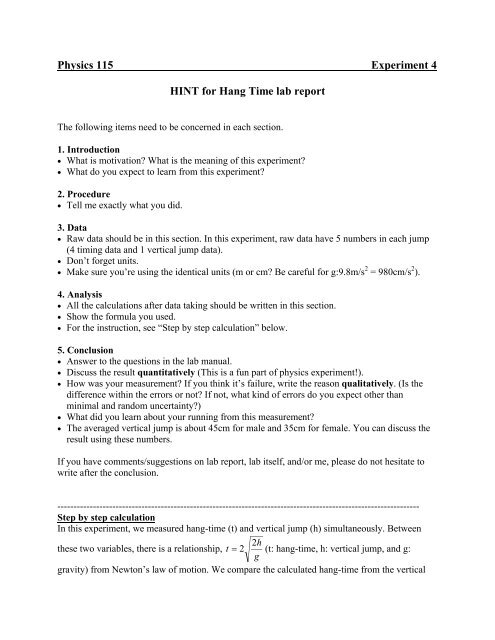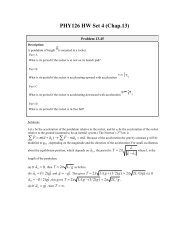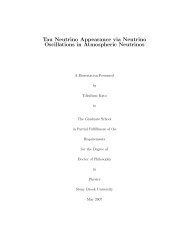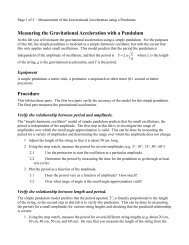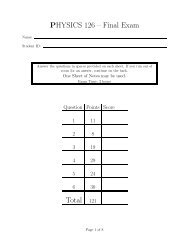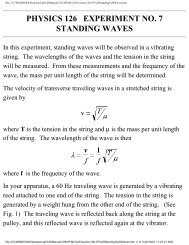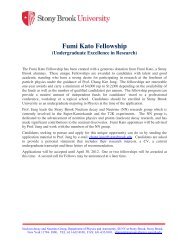Physics 115 Experiment 4 HINT for Hang Time lab report
Physics 115 Experiment 4 HINT for Hang Time lab report
Physics 115 Experiment 4 HINT for Hang Time lab report
You also want an ePaper? Increase the reach of your titles
YUMPU automatically turns print PDFs into web optimized ePapers that Google loves.
<strong>Physics</strong> <strong>115</strong> <strong>Experiment</strong> 4<br />
<strong>HINT</strong> <strong>for</strong> <strong>Hang</strong> <strong>Time</strong> <strong>lab</strong> <strong>report</strong><br />
The following items need to be concerned in each section.<br />
1. Introduction<br />
What is motivation What is the meaning of this experiment<br />
What do you expect to learn from this experiment<br />
2. Procedure<br />
Tell me exactly what you did.<br />
3. Data<br />
Raw data should be in this section. In this experiment, raw data have 5 numbers in each jump<br />
(4 timing data and 1 vertical jump data).<br />
Don’t <strong>for</strong>get units.<br />
Make sure you’re using the identical units (m or cm Be careful <strong>for</strong> g:9.8m/s 2 = 980cm/s 2 ).<br />
4. Analysis<br />
All the calculations after data taking should be written in this section.<br />
Show the <strong>for</strong>mula you used.<br />
For the instruction, see “Step by step calculation” below.<br />
5. Conclusion<br />
Answer to the questions in the <strong>lab</strong> manual.<br />
Discuss the result quantitatively (This is a fun part of physics experiment!).<br />
How was your measurement If you think it’s failure, write the reason qualitatively. (Is the<br />
difference within the errors or not If not, what kind of errors do you expect other than<br />
minimal and random uncertainty)<br />
What did you learn about your running from this measurement<br />
The averaged vertical jump is about 45cm <strong>for</strong> male and 35cm <strong>for</strong> female. You can discuss the<br />
result using these numbers.<br />
If you have comments/suggestions on <strong>lab</strong> <strong>report</strong>, <strong>lab</strong> itself, and/or me, please do not hesitate to<br />
write after the conclusion.<br />
----------------------------------------------------------------------------------------------------------------<br />
Step by step calculation<br />
In this experiment, we measured hang-time (t) and vertical jump (h) simultaneously. Between<br />
2h<br />
these two variables, there is a relationship, t 2 (t: hang-time, h: vertical jump, and g:<br />
g<br />
gravity) from Newton’s law of motion. We compare the calculated hang-time from the vertical
jump measurement to the direct hang-time measurement to check this relationship. The errors to<br />
be considered are minimal uncertainty and random uncertainty.<br />
1. Vertical jump measurement<br />
In terms of vertical jump data, you don’t need to calculate minimal uncertainty. There<strong>for</strong>e, you<br />
have already 10 jumps data without errors. Calculate the average, which is your final vertical<br />
jump data. To calculate the random uncertainty, calculate the difference between the average and<br />
each vertical jump. Then maximum difference is the random uncertainty. (Strictly speaking, you<br />
need to calculate standard deviation. To make it simpler, I just take the maximum difference. If<br />
you can calculate standard deviation, do it. I’ll give you extra points.)<br />
Example) 10 vertical jumps: 0.58m, 0.58m, 0.64m, 0.60m, 0.60m, 0.60m, 0.60m, 0.60m,<br />
0.60m, 0.60m.<br />
0.58 0.58 0.64 0.60 0.60 0.60 0.60 0.60 0.60 0.60<br />
The average is h <br />
0. 60m<br />
10<br />
The maximum difference is h 0.64<br />
0.60 0. 04m<br />
There<strong>for</strong>e, the vertical jump is 0.60<br />
0.04m<br />
2. Calculate hang-time from the vertical jump measurement<br />
2h<br />
Using the <strong>for</strong>mula, t 2 , hang-time is calculated. The error is also calculated from this<br />
g<br />
<strong>for</strong>mula. Because the parameters other than h are all constant, just plug in the error into this<br />
<strong>for</strong>mula.<br />
Example) The vertical jump is<br />
t 2<br />
t<br />
2<br />
2h<br />
g<br />
2<br />
2h<br />
2<br />
g<br />
2<br />
0.60m<br />
2<br />
9.8m<br />
/ s<br />
2 0.04m<br />
2<br />
9.8m<br />
/ s<br />
There<strong>for</strong>e, the hang-time is<br />
0.70m<br />
0.60<br />
0.04m<br />
.<br />
0.18m<br />
0.70<br />
0.18m<br />
3. Direct hang-time measurement<br />
For the jump starting time, you have two numbers, t 1i and t 1f . For the jump end time, you have<br />
two numbers, t 2i and t 2f . The starting time (T 1 ) is the average of these two numbers, namely:<br />
t1<br />
i<br />
t1<br />
f<br />
T1<br />
. Then minimal uncertainty (ΔT 1 ) <strong>for</strong> the starting time is<br />
2<br />
t1<br />
i<br />
t1<br />
f<br />
T1<br />
T1<br />
t1<br />
i<br />
t1<br />
i<br />
. From the same calculation, you can get the end time with the<br />
2<br />
minimal uncertainty ( T2 T2<br />
). Then the hang-time t T 2<br />
T1<br />
. The error of the hang-time is<br />
2<br />
2<br />
2<br />
t T 1<br />
T<br />
because this is subtraction (See exp #1 <strong>lab</strong> manual.).
Example) t1 i<br />
0.98sec,<br />
t1<br />
f<br />
1.02sec, t2i<br />
1.70sec, t2<br />
f<br />
1.76sec<br />
t1<br />
i<br />
t1<br />
f 0.98 1.02<br />
T1<br />
1.00, T1<br />
T1<br />
t1<br />
i<br />
1.00 0.98 0.02<br />
2 2<br />
t2i<br />
t2<br />
f 1.70 1.76<br />
T2<br />
1.73, T2<br />
T2<br />
t2i<br />
1.73 1.70<br />
0.03<br />
2 2<br />
t T<br />
2<br />
T<br />
1<br />
1.73 1.00<br />
0.73sec, t<br />
<br />
There<strong>for</strong>e, hang-time is 0.73<br />
0. 04 sec<br />
T<br />
2<br />
1<br />
T<br />
2<br />
2<br />
<br />
0.02<br />
2<br />
0.03<br />
3<br />
0.036<br />
Using the obtained 10 hang-time data, calculate the average and random error just like vertical<br />
jump calculation. You have 10 minimal uncertainties and 1 random uncertainty. For the final<br />
error, take maximum uncertainty.<br />
4. Comparison between direct-measured and calculated hang-time<br />
In the analysis section, compare the obtained numbers from direct hang-time measurement and<br />
calculated hang-time from vertical jump measurement. The discussion should be in the<br />
conclusion.


